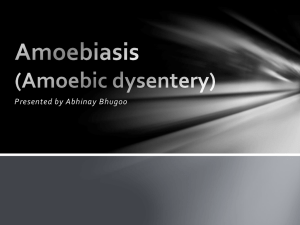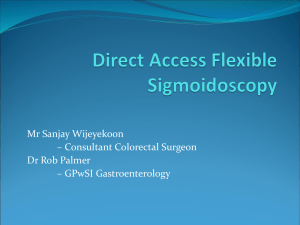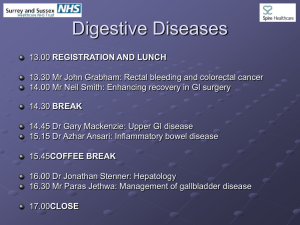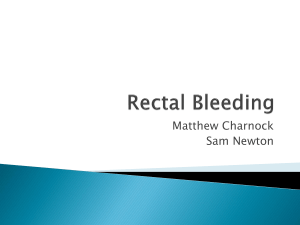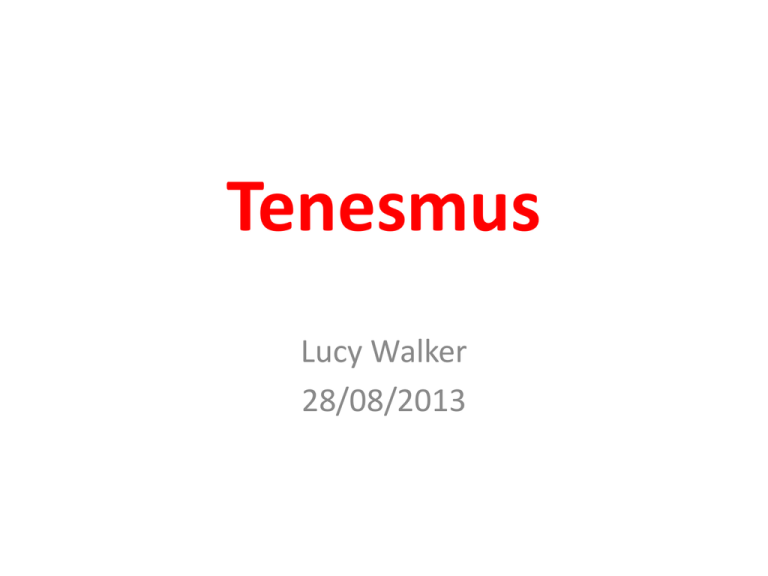
Tenesmus
Lucy Walker
28/08/2013
2010 Palliative Medicine Curriculum
• “Know about the causes of tenesmus”
• “Assessment and management of tenesmus”
Overview
•
•
•
•
•
•
Definition
Mechanism
Causes
Assessment
??Investigations
Management Options
By the end of the session
• Refreshed memory on causes of tenesmus
• Better understanding of treatment options
and their evidence base
Tenesmus
• A sensation of incomplete evacuation
• Often accompanied by a sensation of urgent
or abnormally frequent desire to defecate
with involuntary straining, but little bowel
movement
• Can experience painful spasm of the anal
sphincter or smooth muscle
Mechanism
• Disorder of rectal motility due to:
– Reduced compliance
– High amplitude pressure waves in rectal wall
– Increased sensitivity to distension
• Mixed nocioceptive and neuropathic elements
Causes
• Carcinoma esp of rectum
• Post radiotherapy
• Faecal Impaction
•
•
•
•
Rectal prolapse/ polyps/ fissure/ adenoma/ internal haemorrhoids
Inflammatory Bowel Disease/ Proctitis
Foreign Body
Infection
Assessment
• When did it start?
• Is there a constant urge to empty bowels and
how much stool is passed?
• Any abdominal pain and where?
• Any diarrhoea and vomiting?
• Is blood passed?
• Any unusual or high risk foods?
• Ill contacts?
Investigations??
• Patient dependant
• Might consider:
– Stool culture
– Inflammatory markers
– Sigmoidoscopy or colonoscopy
Management
• Depends on underlying cause
• Prevent constipation with stool softeners
• Treat faecal impaction
• Antibiotics if confirmed infection
Opiates
• Often a poorly opiate responsive pain (Hanks,
1991) but…
– Should still be tried
• ?Methadone
– Mercadante et al (2001)
• 1 case report suggesting benefit when escalating
Morphine doses unhelpful
Adjuvant Analgesia
• Anticonvulsants
• Amitriptyline
– Use with caution as can cause constipation and
exacerbate symptoms
• NSAIDs
Steroids
• Dexamethasone 4-16mg may provide some
relief
– Peritumour oedema
– inflammation
Nitrates & Calcium Chanel Blockers
• GTN paste or 2% ointment
– Often not tolerated due to headache
• Nifedipine
– McLoughlin & McQuillan, 1997
• Reduce smooth muscle spasm so can help with
elements of tenesmus pain
• Case series evidence (3/4 patients gained benefit)
• 10 to 20mg BD M/R preparation
Radiotherapy
• Can be helpful for symptom control especially
if a locally advanced rectal tumour (Midgley &
Kerr, 1999)
• Less effective in patients who have had
surgery
• May be most useful in those who have not
received chemotherapy
Lumbar Sympathectomy
• Bristow (1988)
– Prospective study
– Bilateral chemical lumbar sympathectomy with phenol
– 12 patient with cancers and tenesmus unresponsive to
pharmocological agents
– 80% gained complete pain relief, 1 partial and 1 no
relied
– All remained symptom free to latest follow up (7
months)
– 1 patient had hypotension post op
Epidural or Intrathecals?
• No papers specifically for tenesmus
• Local anaesthetic or opiate
• Lots of anecdotal reports
Endoscopic Laser Treatment and
Metal Expandable Stents
• Laser Treatment:
– Gevers (2000)
• Palliative laser therapy for symptom control
• 80% (21) of those with “other symptoms” (including
tenesmus) gained symptom relief until death or end of study
• 4% perforation rate and 5 (of 219) died due to procedure
• Metal Expandable Stents:
– Rey (1995)
• Stents safe to insert and reduce laser sessions
• ?more for relieving obstruction than tenesmus
Bulletin Board
• Loperamide
• Botox
– ?for radiation proctitis
• Anti-spasmodics at end of life
Summary
• Mixed nocioceptive and neuropathic pain
• Consider underlying cause and don’t forget
non-malignant causes
• Prevent constipation
• Often unresponsive to opiates
• No guidelines and no good evidence to
recommend one treatment over another
References
•
•
•
•
•
•
•
•
•
•
•
•
•
Berger, Shuster & Von Roenn Eds. (2012) Principles and Practice of Palliative Care
and Supportive Oncology. Lippincott William & Wilkins, US
Bristow A & Foster JMG (1998) Lumbar Sympathectomy in the management of
rectal tenesmus pain. Annals of the Royal College of Surgeons of England. 70: 38-9
Gervers AM et al (2000) Endoscopic laser therapy for palliation of patients with
distal colorectal cancer: analysis of factors including longterm outcome.
Gastrointestinal Endoscopy. 51(5):580-5
Hanks (1991) Opioid-responsive and opioid non-responsive pain in cancer. British
Medical Bulletin. 47(3):718-731
McLoughlin R & McQuillan R (1997) Using Nifedipine to treat tenesmus. 11: 419
Mercadante et al (2001) Methadone in treatment of tenesmus not responding to
morphine escalation. Support Care Cancer 9:129-30
Midgley R & Kerr D (1999) Colorectal Cancer. Lancet 353:391-99
Rey J-F et al (1995) Metal stents for palliation of rectal carcinoma: a preliminary
report. Endoscopy. 27(7):501-4
Sedgwick et al (1994) Pathogenesis of acute radiation injury to the rectum.
International Journal of Colorectal Disease. 9:23-30
book.pallcare.info
Palliativedrugs.com
Oxford Handbook of Palliative Medicine
If you can access them:
–
–
Rich A, Ellershaw E. Tenesmus / rectal pain - how is it best managed? CME Bulletin Palliat Med 2000;2(2):41-44
Hunt RW. The palliation of tenesmus. Palliat Med 1991;5:352-53


